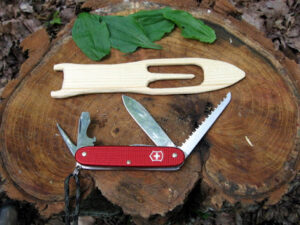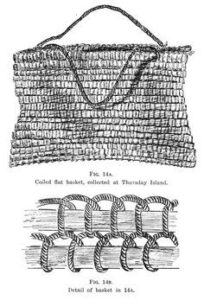Decades ago, just off Regent Street, London had the Museum of Mankind. The museum no longer exists on that site. The premises was closed down and the exhibits merged with the British Museum. The collection at the British Museum is vastly greater than the space available for display so I suspect many of the items from the Museum of Mankind have been sitting in boxes, unviewed for years at a time.
My visits to the Museum of Mankind coincided with an exhibition on Papua New Guinea. There were many interesting things to see. For example, the arrows on display had neither nocks or flights. They were drag-stabilized with a blob of tree gum added just behind the head to adjust the balance. Rather than strings the bows had a broad strap as wide as the base of the arrow.

One of the things that fascinated me was the net bags on display. These were constructed using a repeating multiple knot that reminded me of a figure-eight knot. This technique has been called “knotless” but I tend to think of it as multiple interwoven knots or even one vast, complex knot!
The bags made by this technique are called “bilum” on many webpages so we will call this technique of construction “bilum knotting”.
If you have read my book on knots you will know at least two ways to make nets. Bilum knotting creates and expanding bag useful for carrying loads in. Such bags are used to carry everything from phones to babies.
Images of how the knotting is actually done are relatively rare on the internet. Below is the best I could find and I have coloured certain parts in to give a better appreciation of how it works.



Red is the first row, and could have been made going from left to right. I have coloured some of the second row green to illustrate better how it attaches to the previous row. While the second row looks identical it was probably constructed moving from right to left. The lighter green threads show how a row is ended to create a new row. Start the first row with a slip knot.
All this looks complicated but is actually relatively simple. Connect with a neighbour first, then the row above. The most tedious part is pulling the yarn through each new knot. I suggest you find a suitable piece of wood or plastic and make yourself a net-mender’s needle.
All this looks complicated but is actually relatively simple. Connect with a neighbour first, then the row above. The most tedious part is pulling the yarn through each new knot. I suggest you find a suitable piece of wood or plastic and make yourself a net-mender’s needle.

To keep the knots even the yarn is looped around strips of flat material. Traditionally long leaves were used. More common now is to use strips of plastic strapping. Created using a former such as this the knots/loops look more like a “ ∫ ” than an “8”. Rulers might make handy formers.


A mandatory charge has been introduced to encourage us to re-use our shopping bags. A bilum net bag may be a useful alternative. It packs up small in a pocket and can carry a large volume.